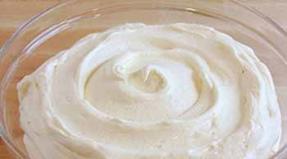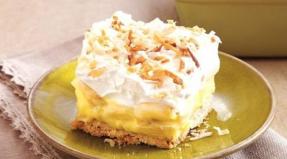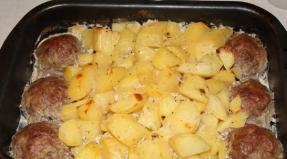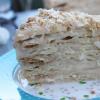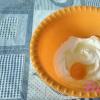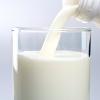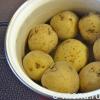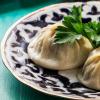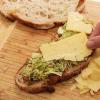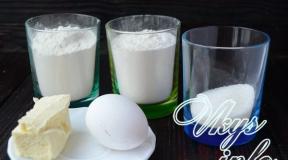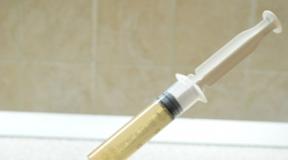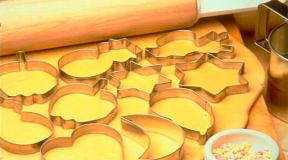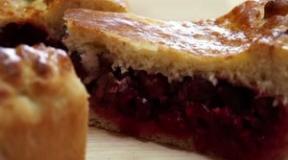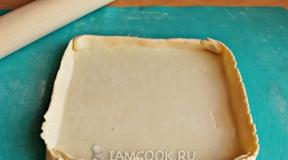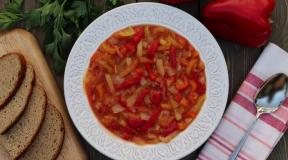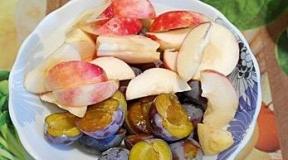Tatar national dishes in the Tatar language. Dishes of the national Tatar cuisine
Tatar cuisine... perhaps one of the most delicious and famous in the whole world.
NATIONAL TATAR DISHES
The Tatars, who are descendants of the Turkic-speaking tribes, took a lot from them: culture, traditions and customs.
It is from the times of the Volga Bulgaria - the progenitor of Kazan, that the Tatar cuisine begins its history. Even then, in the XV century. this state was a highly developed commercial, cultural and educational city, where peoples of various cultures and religions lived together. In addition, it was through it that the great trade route connecting the West and the East passed.
All this undoubtedly affected the modern traditions of the Tatars, including the Tatar cuisine, which is distinguished by its variety of dishes, satiety, simplicity of manufacture and elegance at the same time, and, of course, extraordinary taste.
Basically, traditional Tatar cuisine is based on dough dishes and various fillings.
Well, let's start getting to know each other?
Tatar hot dishes
Bishbarmak
Translated from the Tatar "bish" is the number 5, "barmak" is a finger. It turns out 5 fingers - this dish is eaten with fingers, all five. This tradition dates back to the times when the Turkic nomads did not use cutlery while eating and took meat with their hands. This hot dish, consisting of finely chopped boiled meat, lamb or beef, with chopped onion rings, and unleavened boiled dough in the form of noodles, all of this is very peppery. Served on the table in a cauldron or cast iron, and from there everyone already takes with his hands as much as he wants. Together with him they usually drink hot, rich meat broth, slightly salted and peppered.
Tokmach
Traditional chicken noodle soup that includes potatoes, chicken meat and finely chopped homemade noodles. This dish has a special taste due to the combination of these products. Yes, the soup is really incredibly tasty and rich.
Already on the plate, the soup is usually sprinkled with a small amount of herbs (dill, or green onions).
This is a fairly light dish that does not cause any heaviness in the stomach.
Azu in Tatar
It is a stew (beef, or veal) with potatoes and pickles, with the addition of tomato paste, bay leaves, garlic, onions, and, of course, salt and pepper. Prepared in a cauldron or other cast-iron dish. Delightful, very satisfying dish!
Kyzdyrma  Traditional roast, consisting of horse meat (less often lamb, beef or chicken). The meat is fried in a skillet that is very hot with fat. Fried meat, as a rule, is laid out in a roaster or other elongated shape, onions, potatoes, salt, pepper, bay leaves are added, and the whole thing is stewed in the oven. The dish has a very beautiful appearance, and most importantly, an incredible smell and taste!
Traditional roast, consisting of horse meat (less often lamb, beef or chicken). The meat is fried in a skillet that is very hot with fat. Fried meat, as a rule, is laid out in a roaster or other elongated shape, onions, potatoes, salt, pepper, bay leaves are added, and the whole thing is stewed in the oven. The dish has a very beautiful appearance, and most importantly, an incredible smell and taste!
Katlama
Steamed meat rolls. In addition to minced meat, the dish includes potatoes, onions, flour, eggs. Katlama is a Tatar manty, so it is cooked in a mantis. After cooking, it is cut into 3 cm thick pieces, poured with melted butter and served on the table. The dish is usually eaten with hands.
Tatar pastries
Echpochmaks
Translated from the Tatar "ech" - means the number 3, "pochmak" - the angle. It turns out 3 corners, or a triangle. This is the common name for this dish.  They are juicy, very tasty pies with finely chopped meat (preferably lamb), onions and potatoes. Sometimes a little fat tail fat is added to the filling. Echpochmaks are prepared from unleavened or yeast dough.
They are juicy, very tasty pies with finely chopped meat (preferably lamb), onions and potatoes. Sometimes a little fat tail fat is added to the filling. Echpochmaks are prepared from unleavened or yeast dough.
The peculiarity of this dish is that the filling is placed raw in the dough. Salt and pepper must be put in it.
Triangles are baked in the oven for about 30 minutes. Served with salted and peppered rich meat broth.
Peremyachi
Pies fried in a pan with a lot of oil or special fat. Prepared from unleavened or yeast dough with meat filling (usually ground beef with finely chopped onions, ground pepper). They have a rounded shape. A very satisfying and tasty dish! Served with sweet tea.
Kystyby
They are flat cakes with potatoes. Tortillas are prepared from unleavened dough in a highly heated frying pan, without oil. Mashed potatoes are prepared separately, which are then put in small portions in each cake. Kystybiyki are very soft, tender, nourishing and incredibly tasty! They are usually consumed with sweet tea.
Balesh
Delicious, hearty pie made from potatoes and duck or chicken meat.  Prepared mainly from unleavened dough. The filling is put in large quantities. Fatty meat juice is periodically added to a small hole on top during cooking.
Prepared mainly from unleavened dough. The filling is put in large quantities. Fatty meat juice is periodically added to a small hole on top during cooking.
Types of pie: vak-balesh (or elesh) - "small" and zur-balesh - "big".
Whatever the size of the ballesh, it is always a real holiday!
Tatar snacks
Kyzylik
Another name is horse meat in Tatar. This is uncooked smoked horse meat (in the form of sausage), dried using a special technology, with the addition of spices and salt. It is believed to have a beneficial effect on men's health, gives strength and energy.
Kalzha  One of the popular types of traditional appetizer, consisting of lamb meat (beef or horse meat) topped with spices, garlic, salt, pepper and vinegar. Then the meat is wrapped, turning it into a roll, and fried in a pan. After cooking, the roll is divided into parts. The dish is served chilled.
One of the popular types of traditional appetizer, consisting of lamb meat (beef or horse meat) topped with spices, garlic, salt, pepper and vinegar. Then the meat is wrapped, turning it into a roll, and fried in a pan. After cooking, the roll is divided into parts. The dish is served chilled.
Tatar tenderloin
The tenderloin is fried in animal fat, then stewed by adding onion, carrots, sour cream cut into rings. The finished dish is laid out in a special elongated dish, boiled potatoes are placed next to it, all this is sprinkled with herbs. If you wish, you can add more cucumbers and tomatoes.
Tatar sweets
Chak-chak  A sweet treat made from honey dough. The dough resembles brushwood, consists of small balls, sausages, flagella, cut in the form of noodles, fried in a large amount of oil. After their preparation, everything is poured with honey (with sugar). Usually chak-chak is decorated with nuts, grated chocolate, candies, raisins. Cut into pieces, use with tea or coffee. As they say - you will lick your fingers!
A sweet treat made from honey dough. The dough resembles brushwood, consists of small balls, sausages, flagella, cut in the form of noodles, fried in a large amount of oil. After their preparation, everything is poured with honey (with sugar). Usually chak-chak is decorated with nuts, grated chocolate, candies, raisins. Cut into pieces, use with tea or coffee. As they say - you will lick your fingers!
Gubadia  A sweet cake that has several layers. Its filling consists of boiled rice, eggs, korta (dried cottage cheese), raisins, dried apricots and prunes. For the manufacture of gubadia, yeast or unleavened dough is used. This dish is one of the most delicious in Tatar cuisine. Prepared for holidays, big celebrations. Tea is usually served with the pie.
A sweet cake that has several layers. Its filling consists of boiled rice, eggs, korta (dried cottage cheese), raisins, dried apricots and prunes. For the manufacture of gubadia, yeast or unleavened dough is used. This dish is one of the most delicious in Tatar cuisine. Prepared for holidays, big celebrations. Tea is usually served with the pie.
Sour cream
A very tender, delicious pie, consisting of yeast dough and sour cream, beaten with eggs and sugar. It is usually served for dessert, with tea. Sour cream literally conceals in your mouth, therefore, sometimes, you don't even notice how you eat it.
Talkysh kelyave
It looks like cotton candy, but they are made from honey. These are small dense pyramids, homogeneous in mass, with an unusual honey aroma. Sweet, melt in your mouth - one sheer pleasure. A very original dish!
Koimak
Tatar pancakes made from yeast or unleavened dough. Koimak can be made from any kind of flour: wheat, oatmeal, pea, buckwheat. It is served with butter, sour cream, honey or jam.
Tatar bread
Kabartma
A dish made from yeast dough, fried in a pan or in an oven under an open fire. Usually eaten hot, with sour cream, or jam.
Icmek
Rye bread made with hop sourdough with the addition of bran and honey. It is baked in the oven for about 40 minutes. They eat it with sour cream or butter.
Tatar drinks
Koumiss
horse milk drink, whitish in color. Pleasant in taste, sweetish-sour, well refreshes.
Kumis can be produced in different ways - depending on the production conditions, the fermentation process and the cooking time. It is strong, with a slightly intoxicating effect, and sometimes weaker, with a calming effect.  It is a general tonic. Possesses a number of useful properties:
It is a general tonic. Possesses a number of useful properties:
- has a beneficial effect on the nervous system;
- possesses bactericidal properties;
- effective for stomach ulcers;
- keeps skin youthful;
- promotes the rapid healing of purulent wounds, etc.
Ayran
A product made from cow, goat or sheep milk, obtained on the basis of lactic acid bacteria. It is a kind of kefir. It looks like liquid sour cream. A light, but at the same time satisfying drink that quenches thirst very well.
Katyk
Translated from the Turkic "kat" means food. It is a kind of curdled milk. It is made from milk, by fermentation with special bacterial cultures. It has its own characteristics that distinguish it from other types of fermented milk drinks, which consists in preparing it from boiled milk, which makes it more fatty. Yes, katyk is a really nourishing drink, and at the same time very healthy!
Traditional milk tea  At the same time, tea can be either black or green, the main thing is that it is strong. A little more than half of the tea is poured into a cup, the rest is filled with milk (preferably cold). It was believed that earlier the nomadic Turkic tribes consumed such tea as food. It is really very satisfying!
At the same time, tea can be either black or green, the main thing is that it is strong. A little more than half of the tea is poured into a cup, the rest is filled with milk (preferably cold). It was believed that earlier the nomadic Turkic tribes consumed such tea as food. It is really very satisfying!
All of the above dishes can be tasted:
- in the Bilyar restaurant chain;
- in the cafe "Tea House";
- in bakeries "Katyk";
- in the "Bakhetle" chain of stores.
GOOD APPETITE!
Culinary traditions of Tatar cuisine evolved for more than one century. While preserving its originality, much in the kitchen changed: it improved, enriched itself with new knowledge and products that the Tatars learned about from their neighbors.
Katyk, bal-may, kabartma were inherited from the Turkic tribes of the Volga Bulgaria period in Tatar cuisine; dumplings and tea were borrowed from Chinese cuisine, pilaf, halva, sherbet from Uzbek cuisine, and pakhleve from Tajik cuisine.
In turn, the experience of Tatar chefs was also in demand. For example, the technology of frying products Russian chefs adopted from the Tatars.
There is no doubt that the composition of the products was primarily influenced by natural conditions and not least by the way of life. For a long time, the Tatars were engaged in sedentary agriculture and animal husbandry, which contributed to the predominance of flour, meat and dairy dishes in food, but a special place in the cuisine of the people was occupied by a variety of pastries.
The original Tatar cuisine took shape in the process of the centuries-old history of the existence of the ethnos and its interaction and contact in everyday life with neighbors - Russians, Mari, Chuvash and Mordovians, Kazakhs, Turkmen, Uzbeks, Tajiks. Thanks to this, the Tatar people have created a cuisine rich in flavors, using the widest range of products from both the Central Russian zone and the southern territories. The natural environment had a significant impact on the formation of the Tatar cuisine, which favorably affected the cultural and economic development of the people. The location at the junction of two geographical zones - the forest North and the steppe South, as well as in the basin of two large rivers - the Volga and Kama - facilitated the exchange of natural products between these two natural zones, as well as the early development of trade.
Tatar cuisine .jpg)
The most typical for traditional Tatar cuisine are soups and broths. Soup-noodles with meat broth is still a must-have dish when receiving guests.
There are many dairy dishes in Tatar cuisine. But, probably, the greatest variety in Tatar cuisine still exists in the recipe for baked goods made from unleavened, yeast, butter, sour, sweet dough. Often they take vegetables for the filling, but pies with pumpkin filling with the addition of millet or rice are especially popular.
The Tatars have always attached great importance to dough, skillfully baking pies from sour (yeast, unleavened, simple and rich, steep and liquid dough). Filled products give Tatar cuisine a special originality. The most ancient and simple pie is kystyby - a combination of unleavened dough (in the form of juicy) with millet porridge and mashed potatoes.
Balish made from unleavened dough stuffed with pieces of fatty meat (lamb, beef, goose, duck, etc.) with cereals or potatoes is considered a favorite and no less ancient. The same category of food includes echpochmak (triangle), peremyach stuffed with minced meat with onions and potatoes.
The variety of fillings is typical for pies - bekken. They are often baked with vegetable fillings (carrots, beets). Pumpkin pies are especially popular.
Tatar cuisine is very rich in pastry and sweet dough products, which are served with tea.
Tea entered the life of the Tatar family early and became a national drink. In general, in the Tatar feast, tea has long become a national drink and an indispensable attribute of hospitality. On the wedding table of the Tatars, there should be such products as chak-chak, baklava, kosh tele (bird tongues), gubadiya, etc. A sweet drink from fruit or honey dissolved in water is also prepared.
Tatar cuisine also has its own food prohibitions. So, according to Sharia, it was forbidden to eat pig meat, as well as some birds, for example, a falcon, a swan - the latter were considered sacred. One of the main prohibitions concerns wine and other alcoholic beverages. The Qur'an notes that in wine, like in gambling, there is good and bad, but the former is more.
.jpg)
HISTORY OF TATAR CUISINE
Culinary art of the Tatar people rich in its national and cultural traditions dating back to the depths of centuries. In the process of centuries-old history, an original national cuisine has developed, which has retained its distinctive features to this day.
Its originality is closely related to the socio-economic, natural living conditions of the people, the peculiarities of its ethnic history.
The Volga Tatars, as you know, descended from the Turkic-speaking tribes (Bulgars, etc.), which settled in the territory of the Middle Volga and the Lower Kama region long before the Mongol invasion. At the end of the 9th - beginning of the 10th centuries. here an early feudal state was formed, which received the name Volga Bulgaria.
Further historical events (especially those associated with the period of the Golden Horde), although they introduced significant complications in the ethnic processes of the region, did not change the established way of the economic and cultural life of the people. The material and spiritual culture of the Tatars, including their cuisine, continued to preserve the ethnic characteristics of the Turkic tribes of the Volga Bulgaria period.
Basically, the composition of the products of the Tatar cuisine was determined by the grain and livestock sector. The Tatars have long been engaged in sedentary agriculture with subsidiary livestock raising. Naturally, grain products prevailed in their diet, and in the late 19th - early 20th centuries, the proportion of potatoes increased significantly. Gardening and horticulture were much less developed than agriculture. Of the vegetables, onions, carrots, radishes, turnips, pumpkins, beets, and only small quantities of cucumbers and cabbage were mainly cultivated. Gardens were more common in the areas of the right bank of the Volga. Apples of local varieties, cherries, raspberries, currants grew in them. In the forests, villagers gathered wild berries, nuts, hops, cow parsnip, sorrel, mint, and wild onions.
Mushrooms were not typical for traditional Tatar cuisine, the enthusiasm for them began only in recent years, especially among the urban population.
The cultivation of grain crops among the Volga Tatars has long been combined with cattle breeding. Large and small ruminants prevailed. Horses were bred not only for the needs of agriculture and transport; horse meat was used as food, it was consumed in boiled, salted and dried forms. But mutton has always been considered the favorite meat of the Volga Tatars, although it does not occupy an exceptional position, as, for example, among Kazakhs and Uzbeks. Along with it, beef is widespread.
Poultry farming was a significant help in peasant farms. Mainly bred chickens, geese, ducks. Living from ancient times in the forest-steppe zone, the Tatars have long known beekeeping. Honey and wax constituted an important source of income for the population.
The dairy cuisine of the Volga Tatars has always been quite varied. Milk was used mainly in processed form (cottage cheese, sour cream, katyk, ayran, etc.).
Tatar dishes .jpg)
FEATURES OF TATAR CUISINE
All dishes can be divided into the following types: liquid hot dishes, second courses, baked goods with unsweetened filling (also served for the second), baked goods with sweet filling served with tea, dainties, drinks.
Liquid hot dishes such as soups and broths are of paramount importance. Depending on the broth (shulpa, shurpa) on which they are cooked, soups can be divided into meat, dairy and lean, vegetarian soups, and according to the products with which they are seasoned, into flour, cereals, flour and vegetables, cereals and vegetables, vegetables. ... In the process of the development of the culture and life of the people, the assortment of national soups continued to be replenished at the expense of vegetable dishes. However, the originality of the Tatar table is still determined by soups with flour dressing, primarily noodle soup (tokmach).
A festive and to some extent ritual dish among the Tatars is dumplings, which were always served with broth. They were treated to a young son-in-law and his friends (kiyau pilmen). Dumplings are also called dumplings with various fillings (from cottage cheese, hemp seeds and peas).
As a second course in traditional Tatar cuisine, meat, cereal dishes and potatoes appear. The second is usually served meat boiled in broth, cut into small flat pieces, sometimes slightly stewed in oil with onions, carrots and peppers. If the soup is prepared in chicken broth, then boiled chicken, also cut into pieces, is served for the second. Boiled potatoes are often used as a side dish, horseradish is served in a separate cup. On holidays, a chicken stuffed with eggs and milk (tutyrgan tavyk / tauk) is cooked.
The most ancient meat and cereal dish is balish, baked in a pot or pan. It is prepared from pieces of fatty meat (lamb, beef, goose or goose and duck offal) and cereals (millet, spelled, rice) or potatoes. Tutyrma, which is a gut filled with chopped or finely chopped liver and millet (or rice), should be referred to the same group of dishes. ... Along with the classic (Bukhara, Persian), a local version was also prepared - the so-called "Kazan" pilaf from boiled meat. Boiled meat and dough dishes, such as kullamu (or bishbarmak), common to many Turkic-speaking peoples, should also be attributed to the variety of meat second courses. Procurement of meat for future use (for spring and summer) is carried out by salting (in brines) and drying. Sausages (kazylyk) are prepared from horse meat; dried goose and duck are considered a delicacy. In winter, the meat is kept frozen.
Poultry eggs, mainly chicken eggs, are very popular among the Tatars. They are eaten boiled, fried and baked.
National dishes.jpg)
Various cereals are widespread in Tatar cuisine: millet, buckwheat, oatmeal, rice, pea, etc. Some of them are very ancient. Millet, for example, was a ritual dish in the past.
A feature of the traditional table is the variety of flour products. Unleavened and yeast dough is made of two types - simple and rich. For baking, add butter, ghee (sometimes horse lard), eggs, sugar, vanilla, cinnamon. The Tatars are very attentive to the dough and know how to cook it well. Noteworthy is the variety (both in form and in purpose) of products made from unleavened dough, undoubtedly more ancient than from sour dough. Buns, cakes, pies, tea dainties, etc. were baked from it.
Products made from sour (yeast) dough are most typical for Tatar cuisine. These primarily include bread (ikmek; ipi; epey). Not a single meal (regular or festive) goes without bread, it is considered sacred food. In the past, the Tatars even had the custom of swearing in bread - ip-der. From an early age, children were taught to pick up every crumb that fell. The elder member of the family cut bread at the meal. The bread was baked from rye flour. Only the wealthy strata of the population used, and even then not always, wheat bread. At present, purchased bread is mainly used - wheat or rye.
In addition to bread, many different products are made from steep yeast dough. The most widespread species in this series is the Kabartma. According to the method of heat treatment, a distinction is made between kabartma baked in a pan in front of a heated oven flame, and kabartma baked in a kettle in boiling oil. In the past, sometimes for breakfast, Kabartma was baked from bread (rye) dough. Cakes were made from bread dough, but from more steeply mixed and thinner rolled out (like juicy). Kabartma and flatbreads were eaten hot, thickly oiled.
Products made from batter are also divided into unleavened and sour. The former include pancakes made from wheat flour (kyimak), the latter - pancakes made from various types of flour (oatmeal, pea, buckwheat, millet, wheat, mixed). Kiyimak made from sour dough differs from Russian pancakes in its greater thickness. It is usually served for breakfast with melted butter on a platter.
Baked products with filling are specific and diverse among the Tatars.
The most ancient and simple of them is kystyby, or, as it is also called, kuzikmyak, which is a flat cake made of unleavened dough, folded in half and stuffed with millet porridge. Since the end of the XIX century. kystyby began to be made with mashed potatoes.
A favorite and no less ancient baked dish is balish made from unleavened or yeast dough stuffed with pieces of fatty meat (lamb, beef, goose, duck, etc.) with cereals or potatoes. Balish was made in large and small sizes, on especially solemn occasions - in the form of a low truncated cone with a hole on top and baked in an oven. Later, this was the name for ordinary pies (with various fillings), reminiscent of Russians in the method of preparation.
.jpg)
Echpochmak (triangle) is also a traditional Tatar dish. stuffed with fatty meat and onions. Later, pieces of potatoes were added to the filling.
Peremyachi constitute a peculiar group of products fried in oil. In the old days, they were made with a filling of finely chopped boiled meat, fried in oil in cauldrons and served with a strong broth for breakfast.
A common product, especially in rural cuisine, is the bakken (or teke). These are pies, larger than usual, oval or crescent-shaped, with various fillings, often with vegetables (pumpkin, carrots, cabbage). Bekken with pumpkin filling is especially popular. The same group should include suma, which is shaped like a pie. The filling is the same as that of bakken, but more often meat (with rice).
A very peculiar product is gubadia, primarily characteristic of the cuisine of the city Kazan Tatars. This round tall pie with a multi-layered filling that includes rice, dried fruit, cottage cheese (a type of cottage cheese) and much more is one of the must-have treats at gala receptions.
Tatar cuisine is very rich in pastry and sweet dough products: chelpek, katlama, kosh tele, lyavash, pâté, etc., which are served with tea. Some pastry products - typical for many Turkic-speaking peoples in terms of content and method of preparation - were further improved, forming original national dishes. One of these original dishes - chek-chek - is an obligatory wedding treat. Chek-chek is brought into the house of her husband by a young woman, as well as by her parents. Chak-chak, wrapped in a thin sheet of dry fruit pastille, is a particularly honorable treat at weddings.
The traditional Tatar cuisine is characterized by the use of a large amount of fat. From animal fats they use: butter and ghee, lard (lamb, cow, less often horse and goose), from vegetable - sunflower, less often olive, mustard and hemp oil.
Of the sweets, honey is the most widely used. Delicacies are prepared from it, served for tea.
The oldest drink is ayran, which is obtained by diluting katyk with cold water. Tatars, especially those who live surrounded by the Russian population, have long also used kvass made from rye flour and malt. During dinner parties, dried apricot compote is served for dessert.
Tea entered the life of the Tatars early, and they are great lovers of it. Tea with baked goods (kabartma, pancakes) sometimes replaces breakfast. They drink it strong, hot, often diluted with milk. Tea among the Tatars is one of the attributes of hospitality.
Other characteristic drinks (non-alcoholic) include sherbet - a sweet drink made from honey, which had at the end of the 19th - beginning of the 20th centuries. only a ritual meaning. For example, among the Kazan Tatars, during a wedding in the groom's house, guests were given a “bride's sherbet”. The guests, having drunk this sherbet, put money on the tray, which was intended for the young.
There are many dairy dishes in Tatar cuisine. Whole milk itself was used only for feeding children or for tea, while the adult population preferred fermented milk products. Katyk was prepared from fermented baked milk. Diluting it with cold water, we got ayran - a drink that quenched thirst well. From the same katyk, they made shuzme (or suzme) - a kind of Tatar cottage cheese. For this, the katyk was poured into bags, which were then hung up to drain the whey. Another type of cottage cheese - eremchek - was prepared from milk, into which leaven was added during boiling, after which they continued to boil until a curd mass was obtained. If they continued to boil until the whey was completely evaporated, then a porous, reddish-brown mass was obtained - court - Tatar cheese. Kort was mixed with butter, boiled with honey (kortla may) and served with tea. Sometimes the cream was simply skimmed off the milk, which was then boiled, getting a delicacy - peshe kaymak - ghee.
Traditional Tatar cuisine is characterized by a large selection of meat, dairy, lean soups and broths (shulpa, ash), the names of which were determined by the name of the products filled in them - cereals, vegetables, flour products - tokmach, umach, chumar, salma. Tokmach noodles, as a rule, were kneaded in wheat flour with an egg.
Umach - round or oblong dough rolls - were often made from sharply kneaded pea-based dough with the addition of some other flour. Salma was made from pea, buckwheat, lentil or wheat flour. The finished dough was cut into pieces, from which the flagella were made. Pieces of the size of a hazelnut were separated from the flagella with a knife or hands, and the middle of each "nut" was pressed with a thumb, giving it the shape of an ear.
Chumar was made from softer dough, which was cut into 1 cm pieces or put into broth like dumplings. From the Chinese cuisine, the Tatars have a tradition of serving dumplings in broth.
Tatar cuisine .jpg)
HEAT PROCESSING OF DISHES,
For understanding the specifics of the national cuisine, the shape of the hearth is of no small importance, with which, in turn, the technology of cooking is associated. The Tatar stove is similar in appearance to the Russian one. At the same time, it has significant uniqueness associated with the ethnic characteristics of the people. It is distinguished by a smaller bed, a low pole, and, most importantly, by the presence of a side ledge with an embedded boiler.
The cooking process was reduced to boiling or frying (mainly flour products) in a kettle, as well as baking in an oven. All kinds of soups, cereals and potatoes were cooked in a cauldron in most cases. It also boiled milk, prepared the lactic acid product kort (red cottage cheese), and fried katlama, baursak, etc. The oven was used mainly for baking flour products, primarily bread.
Frying meat (in fats) is not typical for traditional Tatar cuisine. It took place only in the manufacture of pilaf. Boiled and semi-boiled meat products prevailed in hot dishes. The meat was cooked in soup in large pieces (it was chopped only before eating). Sometimes boiled or semi-boiled meat (or game), divided into small pieces, was subjected to additional heat treatment in the form of frying or stewing in a kettle. Additional processing (roasting) of a whole carcass of a goose or duck was carried out in an oven.
Dishes over an open fire were cooked less frequently. This technology was used in the manufacture of pancakes (teche kyimak) and scrambled eggs (tebe), while the pan was placed on the tagan.
TATAR KITCHEN INVENTORY
The most versatile utensils for cooking in an oven were cast irons and pots. Potatoes were cooked in cast iron, sometimes pea soup, and various cereals were cooked in pots. Large and deep frying pans (for baking byalisha and gubadia) became widespread among the Tatars.
From pottery, besides pots, pots were used for kneading dough, jugs and jugs for storing and carrying dairy products and drinks. Depending on the purpose, they were of different sizes: milk jugs with a capacity of 2-3 liters, and jugs for the intoxicating drink Buza - in 2 buckets.
In the past, among the Tatars, like among other peoples of the Middle Volga and Urals, wooden kitchen utensils were widely used: rolling pins and boards for cutting dough, a mallet for stirring food in the process of cooking and crushing potatoes. To scoop up water (kvass, ayran, buzy), they used slotted (maple, birch) buckets of an oblong shape, with a short handle bent downwards. Food from the boiler and cast iron was taken with wooden ladles.
A set of wooden utensils was also used for baking bread. So, the dough for bread was kneaded in a dough made of tightly fitted rivets tied with hoops. The dough was stirred with a wooden spade. Bread dough was cut into separate loaves in a shallow wooden trough - an overnight stay (zhilpuch), which was also used to knead unleavened dough. The cut loaves were put into wooden or straw-woven cups to "fit". The bread was planted in the oven using a wooden shovel.
The katyk was fermented and transferred in riveted tubs about 20 cm high and 25 cm in diameter. Honey, often ghee, was stored in small linden tubs with a tight lid.
The butter was churned in wooden churns, less often in box churns, or simply in a pot using a whisk. The churns were cylindrical linden tubs up to 1 m in height and up to 25 cm in diameter.
In the kitchen inventory of the Tatars of the late 19th - early 20th centuries. there were wooden troughs for chopping meat, small wooden (less often cast iron or copper) mortars with pestles for grinding sugar, salt, spices, dried bird cherry, and a court. At the same time, large and heavy stupas continued to exist (in the villages), in which groats were peeled. Occasionally they also used homemade croupiers, consisting of two massive wooden circles (millstones).
From the middle of the XIX century. a noticeable expansion of factory-made kitchen utensils. Metal (including enameled), earthenware and glass dishes appear in everyday life. However, in the everyday life of the bulk of the population, especially the rural ones, the kitchen implements of factory production did not receive a predominant value. The oven with the boiler and the corresponding technology of dishes remained unchanged. At the same time, factory tableware entered the life of the Tatars quite early.
Particular attention was paid to tea utensils. They liked to drink tea from small cups (so as not to cool down). Low small cups, with a rounded bottom and a saucer, are popularly called "Tatar". Apart from cups, individual plates, a sugar bowl, a milk jug, a teapot, and teaspoons, the samovar was also the subject of serving the tea table. A brilliantly cleaned, noisy samovar with a teapot on the burner set the tone for a pleasant conversation, a good mood and always decorated the table both on holidays and on weekdays.
Nowadays, there have been great changes both in the methods of cooking food and in the kitchen utensils. The introduction of gas stoves, microwave ovens, etc. into everyday life led to the adoption of new technological methods and dishes, primarily fried ones (meat, fish, cutlets, vegetables), as well as the renewal of kitchen utensils. In this regard, boilers, cast irons, pots, as well as a significant part of wooden utensils, faded into the background. Each family has a large selection of aluminum and enamel pots, various pans and other utensils.
Nevertheless, a rolling pin and a board for rolling out dough, all kinds of barrels and tubs for storing food, baskets and birch bark bodies for berries and mushrooms continue to be widely used in the household. Pottery is also often used.
MODERN TATAR CUISINE
The food of the Tatars, keeping mainly the traditions of the Bulgar cuisine, has undergone significant changes. Due to the dispersion of the Tatars' settlement and the associated loss of national culinary traditions, as well as as a result of global changes in the structure of food in the context of globalization and market relations, many new dishes and products have appeared, and the national cuisine has been enriched. Vegetables and fruits began to occupy a more significant place, the range of fish dishes expanded, mushrooms, tomatoes and salinity entered everyday life. Fruits and vegetables that were previously considered exotic, which became available thanks to international trade - bananas, kiwi, mango, eggplant, etc., have become more often eaten.
The national cuisines of other peoples, especially Russian, had some influence on Tatar cooking. Now, on the dining table of the Tatar family, along with the national Bulgarian dishes, one can see cabbage soup, borscht, fish soup, mushrooms, and cutlets. At the same time, Bulgarian dishes have retained the originality of their design, preparation and taste, which is one of the reasons for their popularity among Russians and other peoples of Russia.
The Tatars have always attached great importance to baking; they skillfully prepared pies from sour, yeast, unleavened, simple and butter dough. The most ancient and simple pie is kystyby - a combination of unleavened dough (in the form of juicy) with millet porridge and mashed potatoes.
.jpg)
RECIPES FOR ORIGINAL TATAR DISHES
Kosh tele
flour -500g
egg - 5 pcs.
milk - 2 tbsp. l.
salt
ghee - 600g
sugar - 1 tbsp. l.
icing sugar - 2-3 tablespoons
tea soda to taste.
Put sugar, eggs, milk, salt to taste, tea soda in a fairly deep bowl and stir until the granulated sugar is completely dissolved. Then add enough flour to make a tough dough.
Roll out the dough 1-1.5 mm thick and use a knife to cut into strips 3-3.5 cm wide. In turn, cut the strips into diamonds 4-5 cm long, which are fried until golden brown with melted butter. Allow to cool, sprinkle with powdered sugar, put in vases.
Tatar cuisine.jpg)
Salma in broth
broth - 2 cups
salma (ready-made) - 80g
onions - 1/2 pc.
pepper, salt - to taste
green onions to taste.
Salt, pepper and salma are added to the strained boiling broth. When the salma floats to the surface, the soup is boiled for another 2-3 minutes and removed from the heat. When serving, sprinkle with finely chopped onions.
gefilte fish.jpg)
Shulpa soup in a pot
For the recipe you will need:
beef or lamb -100g
potatoes -100-150g
carrots -1/3 pcs.
onions - 1/2 pc.
ghee - 2 tsp
broth -1.5 cups
salt and pepper to taste
This soup is prepared in a small (500-600 g) pot. Boil beef or lamb with bone separately. Strain the broth, and cut the meat into 2-3 pieces with bone. Prepared meat, potatoes, carrots, cut into slices, onions, chopped half rings, put in a pot, salt, pepper, add broth, ghee, put in the oven and cook until cooked. Sprinkle with chopped herbs before serving. Shulpa is served on the table in a clay pot with a wooden spoon. Shulpa soup can also be poured from a pot into a deep soup bowl.
Tatar pastries, triangle, echpochmak.jpg)
Balish with duck
For the recipe you will need:
dough - 1.5 kg
duck - 1 pc.
rice - 300-400g
butter - 200g
onions - 3-4 pcs.
broth - 1 glass
pepper, salt - to taste.
Rice is usually added to balish with duck. First, cut the finished duck piece by piece, then cut the flesh into small pieces. Sort the rice, rinse in hot water, put in salted water and boil slightly. Throw the boiled rice into a sieve and rinse with hot water. The cooled rice should be dry. Add oil, finely chopped onion to the rice, the required amount of salt, pepper, mix all this with pieces of duck and make balish.
Knead the dough in the same way as for the previous balisha. Duck balish is thinner than broth balish. Balish is baked for 2-2.5 hours. Broth is poured into it half an hour before readiness.
Balish with duck is served on the table in the same pan. The filling is placed on plates with a large spoon, and then the bottom of the balish is cut into portions.
Stuffed lamb (tutyrgan teke)
For the recipe you will need:
lamb (pulp)
egg - 10 pcs.
milk - 150g
onions (fried) - 150g
oil - 100g
salt, pepper - to taste.
To prepare teke, take the brisket of young lamb or the flesh of the back of the ham. Separate the rib bone from the flesh of the brisket, and trim the flesh from the back so that a pouch is formed.
Separately, break the eggs into a deep bowl, add salt, pepper, melted and cooled butter and mix everything well. Pour the resulting filling into a pre-cooked lamb brisket or ham, sew up the hole.
Put the finished semi-finished product in a shallow dish, pour the broth, sprinkle with chopped onions, carrots and cook until tender. When the tutyrgan teke is ready, place it in a greased frying pan, grease it with oil on top and put it in the oven for 10-15 minutes. Stuffed lamb is cut into portions and served hot.
Tutyrma with beef and rice
For the recipe you will need:
beef (pulp) - 1kg
rice - 100g
onion - 100g
milk or cold broth - 300-400g
salt, pepper - to taste.
Fatty beef (pulp) turn with onions through a meat grinder (you can also chop in a trough), put pepper, salt in the minced meat and mix thoroughly. Add a little milk or cold broth and raw or boiled rinsed rice. The filling for the tutyrma must be liquid.
Fill two-thirds of the processed intestine with the finished filling and tie the open end of the intestine. It is not necessary to fill the tutyrma to capacity, since during cooking the filling (cereal) is boiled, and the shell of the tutyrma may burst. Tie the stuffed tutyrma to a rolling pin, put it in a saucepan with boiling salted water and cook for 30-40 minutes. Serve hot. If desired, the ready-made tutirma can be cut into portions and fried with fat in a pan or in the oven. You can also fry whole. Ayran, cold katyk, and hot meat broth are served with the tutyrma.
meat dishes.jpg)
Kullama
For the recipe you will need:
meat (pulp) - 100g
salma - 75-100g
ghee - 10g
onion -1/2 pcs.
carrots - 1/2 pc.
broth - 2 tbsp. l.
salt, pepper - to taste
liver, heart, kidneys.
Take fatty horse meat, beef or lamb, rinse, separate from the bones, cut into pieces weighing 300-400 g, put in salted boiling water and cook. Remove the meat from the broth, cool and cut into thin pieces weighing 50 g across the fibers. Make a large salma (larger than usual) from wheat flour, boil it in salt water and put it on a sieve. Add the butter to the salma and mix with the chopped meat. In one part of the rich meat broth, put onion, sliced carrots, pepper, bay leaf and cook for 15-20 minutes. Pour the meat mixed with salma with this sauce, close the dish with a lid and simmer for 10-15 minutes. Boiled liver, heart, kidneys can be added to meat.
.jpg)
Gubadia with cottage cheese
For the recipe you will need:
for the test:
butter - 250g
flour - 2 cups
sugar - 100g
vanilla - 1 pinch
salt - 1 pinch
For filling:
cottage cheese - 500g
sour cream - 2 tablespoons
sugar - 150g
vanilla - 1 pinch
egg - 6 pcs.
Prepare the dough. To do this, grind flour and butter into crumbs, gradually adding sugar, salt and vanillin. Prepare the filling in another bowl: mix cottage cheese with eggs, add sugar and vanilla.
Put half of the dough in a mold, crush. Put the filling on the dough, and the rest of the crumbs on the filling.
Put the form with gubadia in an oven preheated to 200C for 30 minutes. Remove the finished cake from the oven, cover with a napkin and leave to cool. You can eat gubadia hot or cold.
national cuisine.jpg)
Kyzdyrma with offal
For the recipe you will need:
lamb heart - 250g
kidneys - 250g
liver - 250g
champignons - 200g
onion - 1 pc.
carrots - 1 pc.
potatoes - 2 pcs.
peas (young pods) - 150g
lemon - 1/2 pc.
flour - 4 tablespoons
olive oil - 200g
dry red wine - 80 ml
parsley (chopped) - 1 tablespoon
dill (chopped) - 1 tbsp.
Demi-glass sauce - 1/2 cup
salt, paprika (ground) - to taste.
Clean the lamb's heart from vessels and films, boil. Cut out the fat from the kidneys, remove the films and soak in cold water for 2-3 hours, then boil. Remove the film from the liver, bread in flour and quickly fry until half cooked. Cut all cooled offal into equal cubes. Cut the champignons into quarters, sprinkle with lemon and fry in 2 tbsp. l. olive oil 4-5 min. Peel the onion, chop, fry in oil until golden brown. Transfer the offal with onions and mushrooms to a saucepan, pour over the sauce and simmer for 7-10 minutes.
For a side dish, peel the potatoes and carrots, boil, cut into large cubes and lightly fry in oil with dill. Blanch the green peas for 1-2 minutes and also fry a little in oil. Serve hot meat with garnish, sprinkle with parsley.
Ingredients:
650 g beef
3 pickled cucumbers
3 onions
300 g potatoes
3 tbsp. tablespoons of tomato paste
2 tbsp. tablespoons of vegetable oil
Bay leaf
salt and ground black pepper - to taste
How to cook lamb basics:
- Take the meat and rinse it under running water. Cut into strips and fry in vegetable oil.
- Peel the onions and carrots, cut into strips and add to the meat.
- Gently lay out tomato paste and cucumbers, previously grated on a fine grater.
- Peel the potatoes, also cut them into strips and place them with the meat.
- Simmer all this under the lid until the meat is fully cooked - about 25 minutes.
- Lamb azu is ready!
Tatar omelet
Shutterstock
Ingredients:
300 ml milk
100 g wheat flour
150 g butter
salt - to taste
How to make a Tatar omelette:
- Beat eggs in a bowl and mix thoroughly until smooth. Add milk and melted butter there. Add salt and flour, beat until thick.
- Grease a frying pan with vegetable oil and pour the resulting mixture onto it.
- Put the skillet on fire and wait for the contents to thicken slightly. Then put it in the oven for 10 minutes. The Tatar omelet should rise.
Kystyby
 Liveinternet
Liveinternet
Ingredients:
200 ml milk
salt to taste
3 cups wheat flour
1 kg of potatoes
150 g butter
150 g green onions
How to cook kystyby:
- Peel, boil and chop the potatoes to make a puree. Put the chopped onion in the puree and stir.
- Mix water, milk, salt and flour. You should have dough. Roll it into tortillas. Bake them in a skillet until browned without oil. \ Put the filling on the finished tortillas and serve.
- Kystyby are ready!
Echpochmak from curd dough
 Shutterstock
Shutterstock
Ingredients:
250 g cottage cheese
250 g butter
200 g sugar
400 g wheat flour
1 teaspoon of baking soda
1 drop of vinegar
How to make echpochmak from curd dough:
- Heat oil in a skillet until soft. Mix it with curd. Add vinegar quenched baking soda to the mixture.
- Then add the flour. Knead the dough and make small tortillas out of it. Dip in sugar and fold in half, then sprinkle with sugar. Make triangles out of the tortillas and bake in the oven until browned.
- Echpochmaks from curd dough are ready!
 Notenoughcinnamon
Notenoughcinnamon
Ingredients:
-
2 sweet peppers
1 clove of garlic
3 tbsp. tablespoons of olive oil
-
salt to taste
2 tbsp. lemon juice
1 cup wheat grits
2 tomatoes
How to make Tatar salad:
- Soak the cereal for an hour in cold water, and then put it in a deep plate.
- Rinse and chop peppers, apples and tomatoes, and then mix with cereals.
- Chop the garlic and herbs very well and mix with vegetable oil and lemon juice. Season with pepper and salt. Use the resulting mixture as a dressing.
- Season the Tatar salad and refrigerate for 50 minutes.
 Smittenkitchen
Smittenkitchen
Ingredients:
100 ml beef broth
4 chicken eggs
salt and pepper - to taste
How to cook Tatar dumplings:
- Pour flour into a deep bowl and beat eggs. Add broth and knead the dough.
- Spoon a piece of dough with a spoon and dip it into the boiling broth. Ready-made Tatar dumplings will float to the surface.
 Shutterstock
Shutterstock
Ingredients:
400 g yeast dough
5 boiled carrots
½ cup vegetable oil
2 tbsp. tablespoons of sugar
How to cook samsa with carrots:
- Hard-boiled eggs, peel and chop.
- Cool the peeled boiled carrots, chop, salt, add eggs and melted butter. Mix everything and roll out the dough.
- Shape into patties and lay out filling. Fry in a significant amount of vegetable oil until browned.
- Samsa with carrots is ready!
 Annabellaskitchen
Annabellaskitchen
Ingredients:
-
salt - to taste
200 g boiled beef
50 g butter
a few slices of bread
4 canned sprat
3 egg yolks
1 onion
How to cook Tatar croutons:
- Fry the bread in butter.
- Twist the meat in a meat grinder, mix with yolks, chopped sprat and pickled cucumber.
- Season with pepper and salt.
- Put the minced meat on the bread, and decorate the Tatar croutons with herbs.
Gubadia in Tatar style with cottage cheese
 Tatsalat
Tatsalat
Ingredients:
300 g butter
2 cups of flour
200 g sugar
450 g cottage cheese
2 tbsp. sour cream spoons
How to cook gubernia with cottage cheese:
- Grind flour and butter into crumbs, gradually adding salt and sugar. Knead the dough.
- To create the filling, mix eggs with cottage cheese and sugar.
- Put half of the dough in a greased baking dish, add the filling, and then sprinkle with the remaining crumbs. Preheat the oven to 200 ° C \ and place the dish with the dish there for 45 minutes.
- Gubardia with cottage cheese is ready!
In a similar way, you can prepare gubadia with dried fruits... Only for her you need to take ready-made yeast dough. Used as a filling: raisins, dried apricots and prunes.
Chak-chak
One of the most favorite sweets, young and old, is the best gift for friends from a trip and a real delicacy and joy on the festive table.
Come to the capital of Tatarstan and not try the national Tatar cuisine?
No, that won't do!
What is the national Tatar cuisine?
All Tatar cuisine can be divided into the following types of dishes:
- Hot meals.
Here the main place will be occupied soups and broths. Soups can be divided into meat, dairy and lean soups. noodle soup(both meat and mushroom). Tatar noodles are "tokmach", and the dough for the noodles is prepared in a special way: only an egg, salt and flour. And it is cut thinly-thinly.
Tatars consider to be a festive dish dumplings, which were traditionally served to a young son-in-law and his friends. Nowadays, not all Kazan residents make Tatar dumplings at home - you can buy good handmade dumplings at Behetle (a supermarket of national food); dumplings are traditionally small, just to say jewelry, with a thin layer of dough). But, of course, the best dumplings are those that are prepared at home.

Second courses.
The second is most often served boiled meat, cut into small flat pieces sometimes lightly sautéed with onions, carrots and peppers. In many Kazan cafes this dish is called "Kazan-style meat". Be sure to try, hearty, incredibly tasty and usually very tender and soft meat.

If the soup was cooked in chicken broth, then for the second there will be chicken, cut into small pieces. One of the favorite side dishes is potatoes.
Another insanely delicious dish is Azu in Tatar style. This is usually beef or lamb stewed with vegetables. Served with potatoes. Pickled cucumber, which is an obligatory part of this recipe, gives a special piquancy to this dish.

- Nourishing pastries (savory)
There are a lot of pastries in Tatar cuisine, moreover, with a sweet and savory filling.
Definitely worth a try "echpochmak"(triangle): A triangular pie filled with potatoes, onions and meat. To come to Kazan and not try echpochmak is simply impossible!

Elesh- a round pie with meat (or beef, or chicken) filling and potatoes. Often served with hot broth. And, having tasted the elesh with broth, you will definitely experience a gastronomic pleasure! Eleshas are small in size, for one person (by the way, it is very convenient to take them with you on a trip, on the road - very satisfying, we ourselves often do this).

And it also happens "zur belesh"- big elesh. This is a huge, fluffy round cake. It is more convenient to order it for the whole company in order to enjoy this miracle of culinary together. Here, the filling can be different: most often meat - lamb, beef, chicken, etc. - with potatoes or cereals)

"Kystyby"- "pancake" from potatoes (fried flatbread stuffed with mashed potatoes or millet porridge) - one of the most ancient and favorite Tatar dishes.

"Peremiach"- this is also a round meat pie (only with minced meat and without potatoes / cereals). In the old days, it was made stuffed with finely chopped meat, fried in oil in cauldrons (cauldrons) and served with a strong broth for breakfast.

- Sweet pastries
First of all it is worth mentioning "chak-chak"(somewhat reminiscent of the Russian "anthill" - "pieces" of dough, fried in oil and smeared with honey).

There is also "baursak"- resembles chak-chak, but differs in taste and consists of large pieces of dough. This is a traditional wedding dish.
By the way, you can learn how to make chak-chak in our master class: from dough to ready-made dish.

Very tasty "gubadia"- a pie stuffed with rice, raisins and a court (a type of cottage cheese).

Interesting "talkysh kaleve"(bird's nests) - small cones made of burnt sugar (very tasty and very laborious!).

Also common sour cream(similar to a cheesecake with cottage cheese, but it is cooked purely with sour cream), various fruit pies - with apples, for example.

Tatly- wonderful marshmallow rolls with dried fruits (dried apricots, prunes) and butter cream. "Tatly" means "sweet, tasty".

And finally - how to wash it all down?
The answer is simple: Tatars always welcomed guests. tea... For the Tatar people, tea drinking is a whole tradition. The samovar was always boiling in the house, and it was customary to drink not one, not two, but about fifteen to twenty cups of tea with a guest! Tea was brewed with herbs, often dried fruits - dried apricots - were added to tea. And with a bit of tea they also ate dates.

By the way, these traditions are still alive today - and during a walk-excursion around the Old Tatar settlement, we will invite you to look into an old Tatar house, where everyone, like more than 100 years ago, drinks tea and has special conversations .. We also know tricky places where master classes on Tatar tea are held.
Where to try Tatar cuisine?
Budget options:

The cafe has been known since Soviet times and still maintains its brand as one of the most delicious places in Kazan. The food is very tasty; many Kazan residents eat there at lunchtime. Here we boldly take all the baked goods, elesh with broth, kystyby. One of the most delicious chak-chaks is also prepared here.
The cafe has two floors. Self-service halls on the ground floor. What is their plus - you immediately see what a particular dish looks like. On the second floor there are two halls, one is served by waiters, the other is self-service.


Cafe Medina is a very atmospheric yet inexpensive place.


Quite good "Alan Ash" at the Kazan-2 station.
Cafe "Chak-chak"- family cafe on 7/10 Bauman street

Another cozy and inexpensive place with national cuisine on the pedestrian street Bauman. It is closer to the Kremlin. I'll tell you a secret that many guides come here to eat between several excursions. Along with the House of Tea, this is a favorite place of the townspeople.
The cafe is aimed at families with children. There is a children's corner, funny bees on the walls, cartoons on TVs. And there is a large selection of not only national pastries, but also cakes!

Cafe "Pomegranate"- a secret tasty place, address - Spartakovskaya 2B.

This is perhaps a secret place. In secret: the staff of the "Kazan Mysteries" often dine here. :) In general, the place is loved by the townspeople who work nearby in numerous office centers. Halal-standard café, girls in national clothes are served here. But here they cook incredibly tasty meat in Kazan style! Large portions, inexpensive and tasty, many national dishes.
The seats are a little more expensive, but not the restaurant check yet
Here you can already sit longer, relax, waiters lead the service.
Bilyar Restaurant is a chain of restaurants serving national cuisine. Addresses in the center: at 15 Vishnevskogo Street, 31 Butlerova, 68 Bolshaya Krasnaya, 61 Ostrovskogo Street. Restaurant service is already emerging, more complex dishes appear (for example, from lamb), there are practically no such dishes in budget cafes. But the check is still not as high as in the options below (under the heading restaurants).


"Gallery of cuisines of the peoples of the world"- Butlerova street 43 / Mushtari 11. Very cozy place. On a budget we mentioned "Alan Ash" in this gallery, but there are many other restaurants too.
Cafe "Fairy Tale"- it would seem strange to list a children's cafe in this segment, but it really deserves it. Address - Bauman 58.

The cafe has been known since Soviet times for its special atmosphere. If you come with children - be sure to stop by! If you are a serious adult - look all the more and plunge into childhood! The ceilings and walls of the cafe are painted with stories from different fairy tales, and the menu is also fabulous. If you want a fabulous continuation - come on the excursion "Tales of Old Kazan" for children and their parents.

Tatar cuisine restaurants
Restaurant "House of Tata Culinary"- the most famous restaurant of national cuisine since Soviet times. Address - st. Bauman 31 (directly opposite the "Tea House"., Do not pay attention to the numbering of the house - there are fewer houses on the odd side of the street). There is already a restaurant service and atmosphere. Perhaps the most pretentious restaurant of Tatar cuisine. Of our guests who have been there, all especially remember zur balish from this restaurant.


Restaurant "Tatarskaya Usadba"- located in an old Tatar estate on the shore of Lake Kaban. A wooden house, a wood-burning stove according to Bulgar technologies, on which cooking, high gates, the Old Tatar settlement - everything is as it should be.


Restaurant in the entertainment complex "Tugan Avylym"(native village in translation from Tatar), not far from the puppet theater - 14/56 Tufan Minnullin St. Tugan avylym looks like a real Tatar village - there are wooden houses, there is even a mill, there are small museum workers in each house, and there is also a monument to Echpochmak. And the restaurant is also made in accordance with national traditions.


Katyk Restaurant - Amirkhan avenue 31B
This restaurant is located in the Novo-Savinovsky district. Also famous for its good Tatar cuisine. By the way, "katyk" is the name of the national milk drink (reminiscent of Russian fermented baked milk).


What national cuisine to bring home and where to buy it?
Firstly, the easiest way is to take the "chak-chak": it does not deteriorate and is well transported. "Chak-chak" in Kazan is sold everywhere: at any gift shop and grocery store. Very tasty "chak-chak" at the 3rd bakery, the House of Tea, the firm "Temle" and "TD Salatov".
We also advise you to look into hypermarket "Behetle"(there is near the railway station in TSUM, on Gorky Park, Sovetskaya Square, in MEGA, not far from the new Vosstaniya-Passenger station - cross the road along Dekabristov Street, on Amirkhan Avenue - in a word, there are a lot of places!). The chain was born in Kazan - now there are stores in Moscow, Nizhny Novgorod and other cities.
In "Behetle", souvenir "chak-chak" is sold in very beautiful packages, and you can also buy all kinds of national pastries. It is also easy to buy here the dessert "tatly", "talkysh kaleve" (in red boxes, usually in the same place as the cakes), and kyzylik - horse sausage. If you are not far away, you can buy handmade Tatar dumplings. If you buy a "talkysh" - take it very carefully, they are fragile.
By the way, there are convenient Behetle kiosks at the metro stations Kremlevskaya, Prospekt Pobedy, Aviastroitelnaya.
Also in Kazan there is culinary network "Katyk"- there is also a national cuisine (you can buy it with you). This culinary network is usually located in the residential areas of Kazan.
The culinary traditions of the Tatar cuisine have been developing for more than one century. The people carefully keep the secrets of national dishes, passing them on from generation to generation.
Liquid hot dishes - soups and broths - are of paramount importance in Tatar cuisine. Depending on the broth (shulpa) in which they are cooked, soups can be divided into meat, dairy and lean, vegetarian, and according to the products with which they are seasoned, into flour, cereals, flour and vegetables, cereals and vegetables, vegetables. The most common first course is noodle soup (tokmach). The second is served meat or chicken boiled in broth, cut into large pieces and boiled potatoes. During dinner parties, especially among the townspeople, pilaf and traditional meat and cereal balish are served. In Tatar cuisine, all kinds of cereals are often prepared - millet, buckwheat, oatmeal, rice, pea, etc. Products made from sour (yeast) dough are highly valued. These primarily include bread (ikmek). Not a single meal (regular or festive) goes without bread, it is considered sacred food. In the past, the Tatars even had the custom of taking an oath with Ipi-der bread.
Kystyby
Unleavened flatbread with mashed potatoes. Sometimes kystyby is made with porridge or vegetable stew. But this is more the exception than the rule.
Peremyach
Cutlet in dough.

Balish
Unleavened dough pie with various fillings.

Elesh
Chicken and potato patties.
flour 600 g.
chicken egg 2 pcs.
sunflower oil 5 tbsp
butter 5 tbsp
baking powder 1 tsp
legs 3 pcs.
potatoes 4 pcs.
onion 1 pc.
To create a dough, you will need to mix a little water, sour cream, vegetable and butter, sugar and salt. In a large container, you also need to sift the flour and combine it with a baking powder. After that, a small depression is made in the center, the mixture of butter is poured there and 2 chicken eggs are broken. When using a fork, mix the yolks and whites well and start stirring in the flour. After that, it is recommended to knead the dough by hand. Thus, it will acquire a homogeneous and elastic mass. When the dough is ready, it must be wrapped in a bag and placed in a cold place.
Next, you will have to deal with the preparation of the chicken legs. To do this, they need to be rinsed well and all white veins removed. It is also necessary to cut the meat off the bones and dry it. After that, the chicken meat will need to be cut into small pieces.
Onions and potatoes are also peeled and cut into small cubes. Then the meat is mixed with finely chopped onions and potatoes. At the same time, salt, pepper and spices are added to taste. You can add a little mustard for an enhanced, rich filling. The filling does not have to be infused for a long time; you can immediately start making eleshas.
The dough is divided into 8 even portions. A little dough is pinched off each. This should make 8 large and 8 miniature balls. It is recommended to roll out large balls and place a small piece of butter and a few spoons of the filling in the center. A small ball of dough also rolls out, but you need to lay it on top of the filling. After that, the edges of the large ball rise up and connect to the top layer of the dough.
In the next cooking step, it is important to heat the oven to 190 degrees. Blanks of eleshas, which are laid out on a baking sheet, will need to be greased with heavy cream or butter. This will make the baked goods crisper. This dish is baked for 45 minutes until a golden crust appears. When the eleshes are completely cooked, it is recommended to cover them with something and allow to cool.
Triangle, echpochmak
Triangular pastries with potatoes and meat, usually lamb.

Becken
Beckens are slightly larger than regular pies and are slightly curved. Most often they are cooked with cabbage and eggs, although there are also options with pumpkin and rice.
Toche koymak
Traditional Tatar pancakes made from yeast dough. Not to be confused with "kaymak". Kaimak is sour cream in Tatar.
Katlama
Steamed meatloaf.
Azu in Tatar
Azu is a favorite dish of many, consisting of fried pieces of meat (beef, lamb or young horse meat), stewed with tomatoes (or tomato sauce), onions, potatoes (often with slices of pickled cucumber) in a spicy sauce.
Kazylyk
Horse meat sausage.

Gubadia
A multi-layered pie, which is most often made from rice, eggs and raisins (prunes or dried apricots) with the addition of kyrt.The mini version of the gubadia is called the uenchek.


Court
Tatar cottage cheese with caramel-creamy taste and pleasant smell.

Chak-chak
Dough product with honey.

Talkysh kaleve
Tatar national sweet. It is somewhat reminiscent of cotton candy, but cotton wool is made from granulated sugar, and talkysh kaleve is made from natural honey. And cotton candy is big and fluffy, and Talysh kaleve are small dense pyramids of a homogeneous mass with a fragrant aroma of honey and ghee. Very sweet, melting in the mouth and giving incomparable pleasure.
